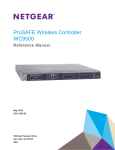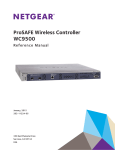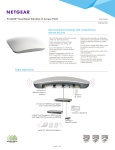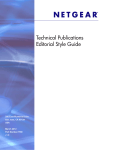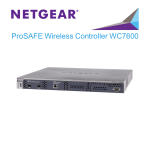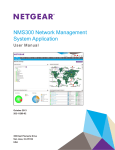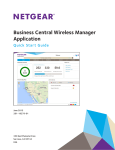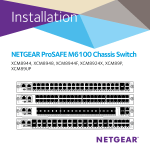Download Netgear WC9500 Installation Guide
Transcript
Installation Guide Set Up the Wireless Controller 2. Enter admin for the user name and password for the password, both in lowercase letters. 1. Configure a computer with a static IP address of 192.168.0.210 and a subnet mask of 255.255.255.0. 3. Click Login. The wireless controller’s web management interface displays. 2. Connect one end of the supplied Ethernet cable to the Ethernet port on the computer and the other end to the Ethernet port on the front panel of the wireless controller. ProSAFE® Wireless Controller WC9500 The ProSAFE Wireless Controller WC9500 lets you manage a large wireless network from a central point, implement security features centrally, support Layer 2 and Layer 3 fast roaming, configure a guest access captive portal, and support Voice over Wi-Fi (VoWi-Fi). In this installation guide, the ProSAFE Wireless Controller WC9500 is referred to as the wireless controller. 3. Connect the supplied power cord from the wireless controller to an AC power outlet. 4. Verify that the following LEDs on the front panel are lit: LED Description Power The green Power LED is lit. If the power light is not lit, check the connections and check to see if the power outlet is controlled by a wall switch that is turned off. Package Contents The package contains the following items: • • • • • • Wireless Controller WC9500 AC power cable Straight-through Category 5 Ethernet cable Rack-mount kit Rubber feet (4) with adhesive backing Installation guide Power LED Mode: Left LED: Green=Link at 1G E, Yellow=Link at 10/100M Right LED:Green=Link, Green Blink=Active Status Fan The green Fan LED is lit, indicating that the fans are functioning correctly. Access the Wireless Controller 1. From the main navigation menu, select Configuration > System > General. Enter a name for the wireless controller and select the country in which the wireless controller is used. Click Apply. 2. Select Configuration > System > Time. Select the time zone in which the wireless controller is used. Optionally, configure the NTP settings. Click Apply. 3. Select Configuration > System > IP/VLAN. Enter the IP settings for your network and the VLANs that you want to assign to the wireless controller. Note: A management VLAN is used for all SNMP and HTTP traffic to and from the wireless controller and managed access points. For large deployments, NETGEAR recommends that the wireless controller and access points are in separate VLANs to ensure uninterrupted connectivity between the wireless controller and the access points. Note: Clear the Untagged VLAN check box only if the hubs and switches in your network support the VLAN (802.1Q) standard. Likewise, change the untagged VLAN value only if the hubs and switches in your network support the VLAN (802.1Q) standard. Click Apply. The connection to the wireless controller is terminated because you have changed its IP address. Stack Master USB Reset Reset button LEDs (top to bottom): Power, Status, Fan, Stack Master Fan 1. On the computer, open a browser. In the address field, type http://192.168.0.250. The wireless controller’s login window displays: The following figure shows the left side of the front panel only: USB port Digital access point counter LED Mode: Green= Link at 10G, Blink Green=10G Active, Yellow=Link at 1G, Blink Yellow=1G Active The Status LED is lit yellow while the wireless controller is initializing. After approximately 2 minutes, when the wireless controller has completed its initialization, the Status LED turns green. Ethernet The right Ethernet port LED is lit green for a 1000 Mbps connection or port yellow for a 100 or 10 Mbps connection. WARNING: DO NOT stack equipment, or place equipment in tight spaces or in drawers. Be sure that your equipment is surrounded by at least 2 inches (5 cm) of air space. ID Status Configure the Basic Settings Slots and LEDs for optional Ethernet port and LEDs SFP GBIC modules 4. Reconfigure your computer with an IP address and subnet mask that is in the same IP subnet as the wireless controller. Use the new IP address of the wireless controller to log in again. 5. Select Configuration > System > DHCP Server. The Discovery Wizard (see Discover Access Points) requires a DHCP server to discover the access points. If you already have a DHCP server in your network, disable the DHCP server on the wireless controller. Otherwise, configure the DHCP settings for the DHCP server on the wireless controller. Click Apply. 3. Connect one end of an Ethernet cable to a LAN port on a router or switch in your network and the other end to the Ethernet port on the front panel of the wireless controller. Note: For extensive information about the Discovery Wizard and the discovery process, see the reference manual. 4. Reconnect the power cord from the wireless controller to an AC power outlet. The LEDs should light as described in Set Up the Wireless Controller. Troubleshooting Tips 6. Decide whether to use the basic profile group (suitable for a small WLAN) or one or more advanced profile groups (suitable for a large WLAN): Discover Access Points • The basic profile group on the wireless controller includes all the features that you can configure for an individual access point: up to 8 profiles (16 for dual-band access points), each of which has its own SSID, security, MAC ACL, rate-limiting settings, WMM settings, and so on. Select Configuration > Profile > Basic > Radio. Configure one or more profiles, each with its SSID and security settings. Click Apply after you have configured a profile. • The advanced profile lets you configure up to 8 profile groups. Each group includes all the settings that are required to configure a fully functional access point with up to 8 security profiles (16 for dual-band access points). Select Configuration > Profile > Advanced > Radio. Configure one or more profile groups, each with one or more profiles that have their own SSID and security settings. Click Apply after you have configured a profile. Note: For extensive information about the configuration options of the wireless controller, including profile groups, see the reference manual. The wireless controller manages selected NETGEAR access points. For a list of supported NETGEAR access points, visits the NETGEAR support site. If the wireless controller and the access points are connected over your network in the same Layer 2, the Discovery Wizard can discover access points that are either in factory default state or already deployed and running. For the Discovery Wizard to discover access points across a Layer 3 network (behind a router) or remote access points, there are more requirements: • • • • Either your network needs to have a DHCP server that has option 43 enabled with the IP address of the wireless controller, or the DHCP server on the wireless controller needs to be accessible to all access points. Each access point needs to have an IP address. Each access point needs to have SNMP and SSH enabled (which is the default). UDP port number 7890 needs to be unblocked in your firewall. To let the wireless controller discover access points: Deploy the Wireless Controller 1. Access the wireless controller at the network IP address that you configured in Configure the Basic Settings. 1. Disconnect the power cord from the wireless controller. 2. Select Access Point > Discovery > Discovery Wizard. Follow the steps onscreen to discover the access points. Review the discovery results. 2. Disconnect the wireless controller from the computer and place it where you intend to deploy it. 3. Select Access Point > Discovery > Managed AP List. Add the access points that you want to be managed by the wireless controller to the Managed AP List. NETGEAR, the NETGEAR logo, and Connect with Innovation are trademarks and/or registered trademarks of NETGEAR, Inc. and/or its subsidiaries in the United States and/or other countries. Information is subject to change without notice. © NETGEAR, Inc. All rights reserved. While the access points are converted from standalone mode to managed mode, the following occurs: Intended for indoor use only in all EU member states, EFTA states, and Switzerland. • • February 2013 NETGEAR, Inc. 350 East Plumeria Drive San Jose, CA 95134 USA • The wireless controller pushes management firmware onto the access points. The access points become DHCP clients and receive an IP address from either the DHCP server in your network or the DHCP server on the wireless controller. The profiles that you have configured on the wireless controller are pushed onto the access points. You cannot access the wireless controller at its default IP address (192.168.0.250): • • • Confirm that the computer is connected to the wireless controller. You might not have restarted the computer with the wireless controller to have TCP/IP changes take effect. Restart the computer. The computer might be set to enable NetBIOS over TCP/IP. Check that TCP/IP is set to use a static IP address of 192.168.0.210 and a subnet mask of 255.255.255.0. (The default TCP/IP setting for Windows is to obtain an IP address automatically.) Restart the computer. After initial configuration, you cannot access the wireless controller at its network address: • • • Use the ping command to verify the connection. Verify that the computer and wireless controller are on the same VLAN. Some of the wireless controller’s default settings might not work with your network. Check the wireless controller’s default settings against the configuration of other devices in your network. Support Thank you for selecting NETGEAR products. After installing your wireless controller, locate the serial number on the label of your wireless controller and use it to register your product at https://my.netgear.com. You must register your wireless controller before you can use NETGEAR telephone support. NETGEAR recommends registering your wireless controller through the NETGEAR web site. For product updates and web support, visit http://support.netgear.com. NETGEAR recommends that you use only the official NETGEAR support resources. You can get the reference manual online at http://downloadcenter.netgear.com or through a link in the wireless controller’s web management interface. For the current EU Declaration of Conformity, visit http://support.netgear.com/app/answers/detail/a_id/11621/.


